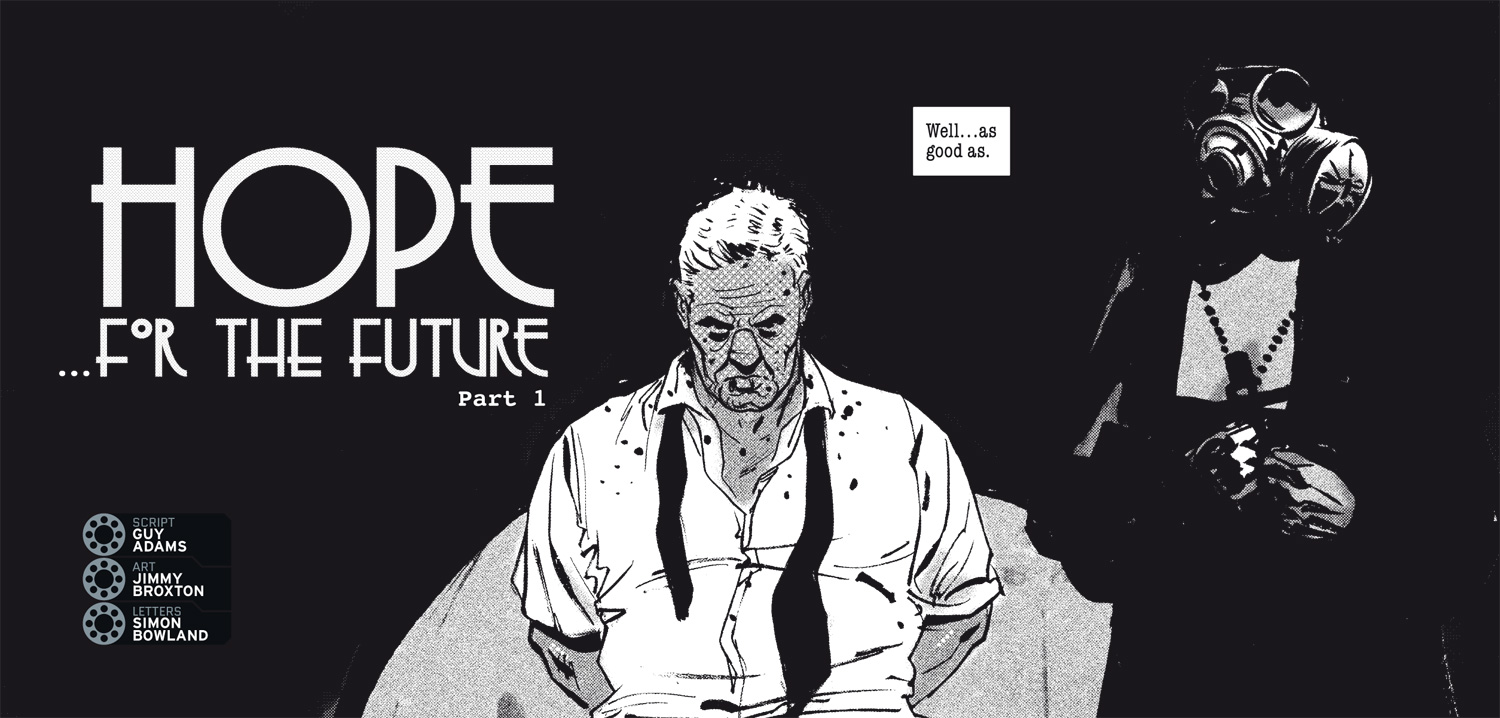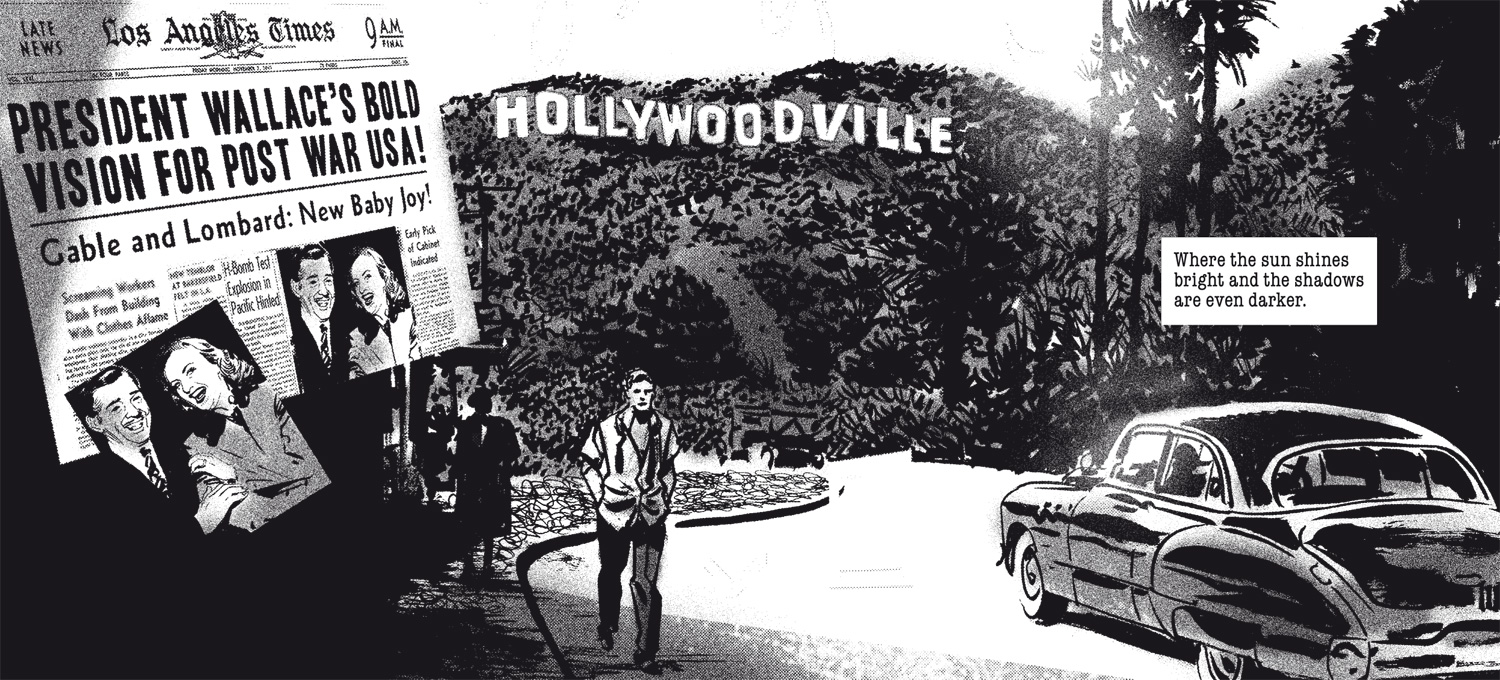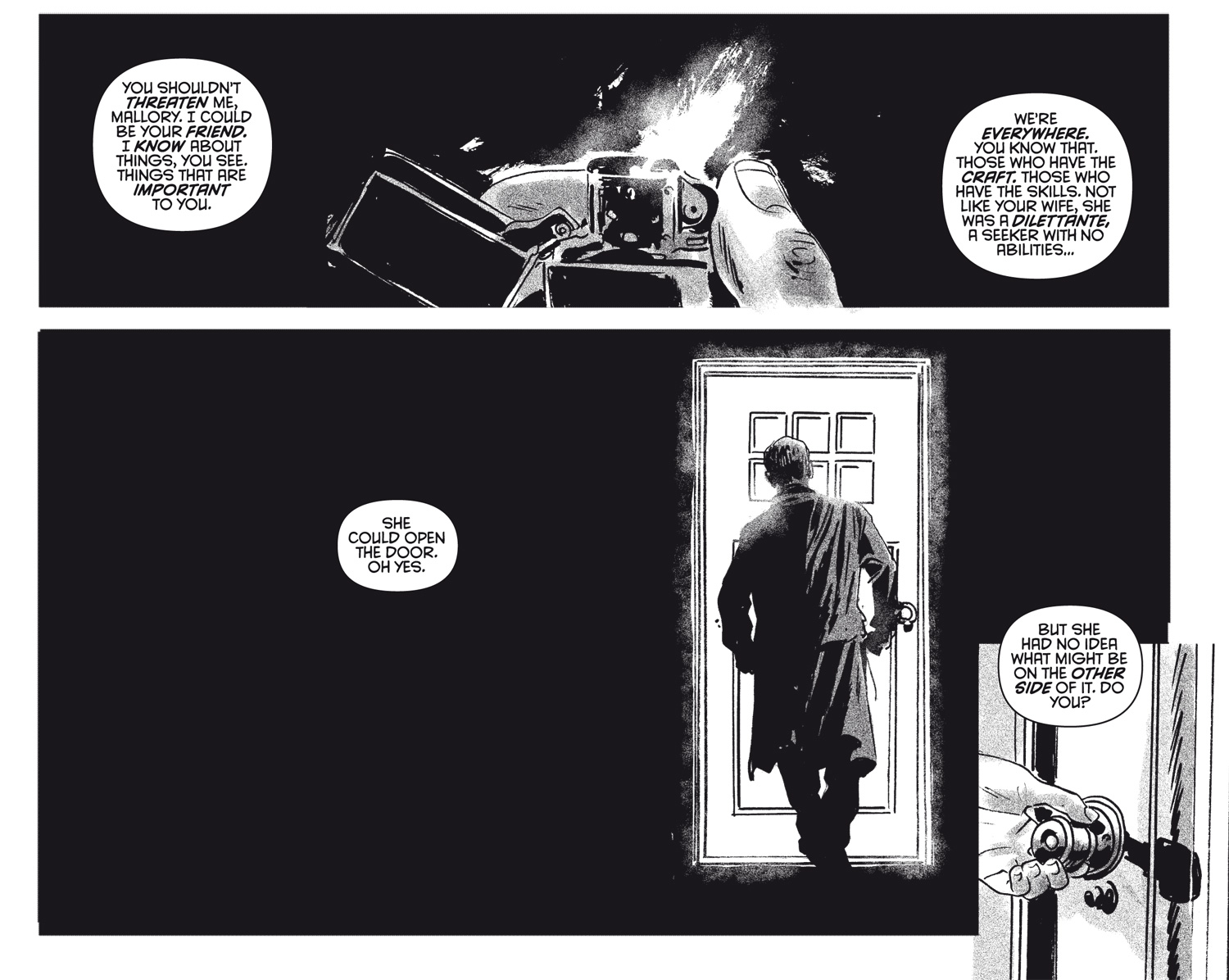INTERVIEW: Hope … for the future with Guy Adams and Jimmy Broxton
16th August 2017
Hope by Guy Adams and Jimmy Broxton returns in 2000 AD Prog 2044 this week after a six month hiatus.
This magic infused noir horror strip is set in an alternate 1940s Hollywood where WWII was won through occult means and this new world has magic at its heart. But magic comes with a heavy price, and practising the dark arts swallows people whole.
One of those people destroyed by magic is Mallory Hope, former New York cop turned Hollywood PI who came back from a nightmarish war only to discover that the nightmare came back as well. His wife was seduced by magic while he was away, and both her and their young son vanished. Hope still believes he can find them, somewhere, somehow and spends his time between cases pursuing that faint hope.
Hope’s a magician who went down too deep, and now the demon Cade is attached to his soul. Cade’s always there, a masked figure only Hope can see, silent, ominous, always keen to see bloodshed once more.
With the first six parts of Hope, we jumped into the case of a missing child star, Joey Fabrizzi, aka Buster Ritz! Against a backdrop of Hollywood glamour, we follow Hope’s investigation as he slowly peels back the glitz to reveal the darkness beneath.
Richard Bruton talked to Guy and Jimmy about the return of the series and what’s in store…
With the new series of Hope debuting in Prog 2044, we’re finally going to see just what happened to Mallory Hope, private dick in an alternate 1940s Hollywood. Can you give us a little insight as to the original genesis for Hope?
G: Jimmy can correct me if I’m wrong but I seem to remember coming to him with a handful of different ideas I thought he’d like. We wanted to do something together again and so I set to thinking what sort of story, what sort of world, had a Broxton written all over it. We were also thinking specifically of 2000 AD as its home so I was just riffing off the tastes and sensibilities of both and finding what might fit.
I can’t actually remember what the other ideas were but Jimmy and I both love film noir and so Hope was an obvious fit. Originally it was set in the future but Matt at 2000 AD very wisely suggested we make it an alternative history story instead.
J: Indeed, incredibly, Guy came up with the idea for whole thing with me in mind to draw it. I’m very lucky!
Now, how does the collaborative process work for you? Both on Hope and generally….
G: I wash, he dries. (I’m stealing from Tom Waits there, but if you’re going to steal…) I always leave room in my scripts for Jimmy to play. Sometimes artists like to be led a bit, sometimes they prefer plenty of room to manoeuvre. With Jimmy we have a basic agreement: I’ll sketch out thoughts and ideas for staging — I do write a full script — but he is entirely free to ignore my suggestions.
J: Guy’s scripts are a joy to work from, everything is there that I need, but as he says, there is room for me to add my own input, things are not set in stone. He understands that comics are primarily a visual medium, he sets the stage, indicates the mood and the tone, I know exactly what information the page needs to impart, exactly what emotional response he wants from the reader, and, as long as I’m true to that, I can do what I like.
How many parts do we have to look forward to in this latest Hope tale? Will this be the conclusion of the search for little Joey or is there more to come?
G: This second run is another six episodes and sees an end to the first story. The case of little Joey is done. There are more stories to follow though.
Can you tease us a little as to what’s coming up in this current series?
G: Sex and violence. Just an average lazy Sunday for Jimmy and I.
J: Some of the things Guy is asking me to draw are very revealing, in a number of ways, and provide remarkable insight into the gin soaked, sun drenched and utterly debauched life he must be living over there.
With Hope, there’s a definite noir feel to the writing, and especially the dialogue, with Chandler’s Marlowe the obvious voice in my head as I’m reading. Guy, is it something you put into Hope through a love of noir fiction and occult thrillers, or is there more to it than that simplistic summary?
G: Oh it’s all love, certainly, although I’ve never read Chandler. I have The Big Sleep here on the shelf but I just haven’t got round to it. Dashiell Hammett’s another glaring omission. Which surprises me just as much as anyone else really. I will read them, I have a lot of books. Thousands of books. Some of them have to wait.
I do read a lot of crime fiction though. Elmore Leonard is a genius, Ed McBain (or Evan Hunter, rather) too, James M. Cain, all sweat and sin and tragedy, Erle Stanley Gardner, his Perry Mason novels are exceptional examples of sleek, fast storytelling. Patricia Highsmith is another essential of course.
J: I’m ashamed to say I have not read any of the writers Guy mentions, I have heard of them, well some of them, I rarely read fiction, but one of my favourite authors is James Elroy, I love the noir/crime genre, horror not so much.
The combination of old time Hollywood noir and magic is a perfect fit, but the thing I loved about the first Hope series, and something I’m hoping to see more of in the future is the alternate history, a post WWII world where magic is commonplace. Will we be seeing more of just how different the Hope world is? And if so, do you feel it’s something better addressed in asides and visual clues as you’ve done so far or could we see the differences take a bigger part of the tale?
G: You’ll certainly be seeing more. It’s prominence will vary (I’m working on several story plots at the moment, building up a future and a landscape for the strip, and in some it’s hugely relevant, in others it’s just window dressing.) Character and story is the key thing, they have to come first, world building should just quietly bubble away in the background unless there’s a strong plot reason for it becoming prominent.
J: I enjoy adding little details that subtly or even subliminally remind us that this is not the world as we knew it, film posters, newspaper headlines, that sort of thing. An example being the famous Hollywood sign, which we see in the first instalment, Guy requested we show it in its original glory; “HOLLYWOODLAND”, which is how it appeared until 1949, when “LAND” was removed, leaving us with the familiar icon of today. The first Hope episode takes place in 1948, so entirely consistent that the sign be shown in full.
Any chance we’ll have a more in depth look at Hope’s wartime nightmare in future series?
G: That’s one of the story plots I’m working on! A short run set entirely during the war. Our plan at the moment is to sprinkle smaller stories between longer runs. The smaller stories will certainly flesh out other parts of this world — and, indeed, other characters.
Jimmy, how did you approach creating the visuals for Hope?
J: I tend to work in the same way for every project, even though the styles may vary. Unless requested, I never do layouts, I just have a vague notion of how the page may hang together. I draw all the panels separately, usually just on cheap typing paper. I then scan them all in, and start composing and editing them down to build the page on the computer.
The combination of gritty noir stylings mixed with the more adventurous overlays of magic work incredibly well. The strip switches from tight, controlled panel work with Hope the PI to more open and expansive pages where magic is involved. Can you talk us through the thinking behind that particular artistic decision?
J: To be honest, I don’t think about it too much, as I said, I do not plan the pages or do layouts, after reading the script I usually know exactly how I’m going to handle each scene, it’s entirely instinctive, to me it just seems obvious how things need to be handled, size, shape, staging etc. Sometimes it feels like the imagery is beaming in from somewhere else, I have no idea where from, the ideas appear fully formed, it’s then just down to me to execute them to the best of my abilities, that’s the hard part, actually drawing and practicing the craft, the thinking is the easy part, I never really do any!
Hope returns to 2000 AD this week in Prog 2044. The original six parts to the series can be found in Progs 2011 through 2016, available from the 2000 AD store. Guy and Jimmy’s Goldtiger is also available from the 2000 AD store and comic shops.





